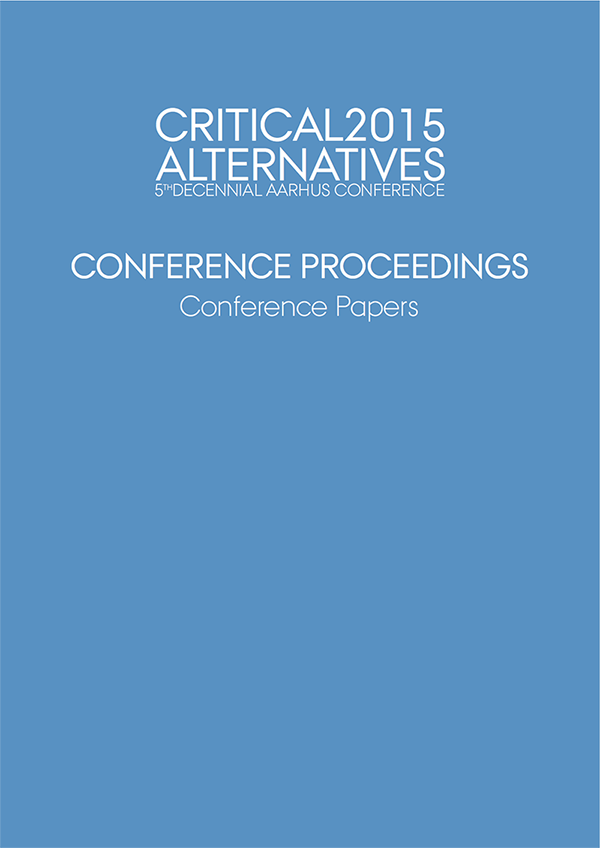Deconstructivist Interaction Design: Interrogating Expression and Form
DOI:
https://doi.org/10.7146/aahcc.v1i1.21313Keywords:
Deconstructivism, Interaction Design, Styles, AestheticsAbstract
In this paper, we propose deconstructivist interaction design in order to facilitate the differentiation of an expressional vo- cabulary in interaction design. Based on examples that illus- trate how interaction design critically explores (i.e., decon- structs) its own expressional repertoire, we argue that there are commonalities with deconstructivist phases in related de- sign disciplines to learn from. Therefore, we draw on the role and characteristics of deconstructivism in the history of archi- tecture, graphic design, and fashion. Afterwards, we reflect on how interaction design is already a means of deconstruc- tion (e.g., in critical design). Finally, we discuss the potential of deconstructivism for form-giving practices, resulting in a proposal to extend interaction design’s expressional vocabu- lary of giving form to computational material by substantiat- ing a deconstructivist perspective.
References
Jeffrey Bardzell. 2009. Interaction criticism and aesthetics. In Proc. CHI 2009 (CHI ’09). ACM, New York, NY, USA, 10. DOI: http://dx.doi.org/10.1145/1518701.1519063
Shaowen Bardzell and Jeffrey Bardzell. 2011. Towards a feminist HCI methodology: social science, feminism, and HCI. In Proc. CHI 2011. ACM, 10. DOI: http://dx.doi.org/10.1145/1978942.1979041
Shaowen Bardzell, Jeffrey Bardzell, Jodi Forlizzi, John Zimmerman, and John Antanitis. 2012. Critical design and critical theory: the challenge of designing for provocation. In Proc. DIS ’12. ACM, 10. DOI: http://dx.doi.org/10.1145/2317956.2318001
Mark Blythe, Jeffrey Bardzell, Shaowen Bardzell, and Alan Blackwell. 2008. Critical issues in interaction design. In Proc. BCS-HCI ’08. BCS, UK, 2. http: //dl.acm.org/citation.cfm?id=1531826.1531880
S. Buchmueller. 2012. How can Feminism Contribute to Design? Reflexions about a feminist framework for design research and practice. In Design Research Society (DRS) International Conference.
Chuck Byrne and Martha Witte. 2001. A brave new world: understanding deconstruction. Graphic Design History (2001), 245.
Anthony Dunne. 1999. Hertzian tales. MIT press London.
Anthony Dunne and Fiona Raby. 2001. Design noir: The secret life of electronic objects. Springer.
Shannon Grimme, Jeffrey Bardzell, and Shaowen Bardzell. 2014. ”We’Ve Conquered Dark”: Shedding Light on Empowerment in Critical Making. In Proc. NordiCHI’14. ACM, New York, NY, USA, 10. DOI: http://dx.doi.org/10.1145/2639189.2641204
Lars Hallna ̈s and Johan Redstro ̈m. 2002. Abstract information appliances: methodological exercises in conceptual design of computational things. In Proc. DIS’02. ACM, New York, NY, USA, 12. DOI: http://dx.doi.org/10.1145/778712.778730
Philip Johnson and Mark Wigley. 1988. Deconstructivist Architecture: The Museum of Modern Art, New York. Little, Brown.
Heekyoung Jung and Erik Stolterman. 2012. Digital Form and Materiality: Propositions for a New Approach to Interaction Design Research. In Proc. NordiCHI’12. ACM, 645–654. DOI: http://dx.doi.org/10.1145/2399016.2399115
Sofie Kinch, Erik Gro ̈nvall, Marianne Graves Petersen, and Majken Kirkegaard Rasmussen. 2014. Encounters on a Shape-changing Bench: Exploring Atmospheres and Social Behaviour in Situ. In Proc. TEI’14. ACM, New York, NY, USA, 233–240. DOI: http://dx.doi.org/10.1145/2540930.2540947
Gizem Kiziltunali. 2012. A deconstructive system: fashion. Konferenssiesitelma ̈. 4th Global Conference, Inter-Disciplinary. Net.
Sang-won Leigh, Asta Roseway, and Ann Paradiso. 2015. Remnance of Form: Altered Reflection of Physical Reality. In Proc. TEI’15. ACM, New York, NY, USA, 2. DOI: http://dx.doi.org/10.1145/2677199.2690874
Ellen Lupton and J Abbott Miller. 1994. Deconstruction and graphic design: history meets theory. Visible language 28 (1994), 346–346.
Matt Ratto. 2011. Critical Making: Conceptual and Material Studies in Technology and Social Life. The Information Society 27, 4 (2011), 252–260. DOI: http://dx.doi.org/10.1080/01972243.2011.583819
Timothy Samara. 2005. Making and breaking the grid: a graphic design layout workshop. Rockport Publishers.
Phoebe Sengers, Kirsten Boehner, Shay David, and Joseph ’Jofish’ Kaye. 2005. Reflective Design. In Proc. CC ’05. ACM, New York, NY, USA, 10. DOI: http://dx.doi.org/10.1145/1094562.1094569
Jan M. Sieber and Ralph Kistler. 2013. Monkey Business. In Proc. TEI’14. ACM, New York, NY, USA, 2. DOI: http://dx.doi.org/10.1145/2540930.2555203
Mitchell Stephens. 1994. Jacques Derrida and Deconstruction. The New York Times Magazine, January 23. (1994).
Anna Vallga ̊rda. 2014a. The Dress Room: Responsive Spaces and Embodied Interaction. In Proc. NordiCHI’14. ACM, New York, NY, USA, 10. DOI: http://dx.doi.org/10.1145/2639189.2639254
Anna Vallga ̊rda. 2014b. Giving Form to Computational Things: Developing a Practice of Interaction Design. Personal Ubiquitous Comput. 18, 3 (March 2014), 577–592. DOI: http://dx.doi.org/10.1007/s00779- 013- 0685- 8
Mikael Wiberg and Erica Robles. 2010. Computational compositions: Aesthetics, materials, and interaction design. International Journal of Design 4, 2 (2010), 65–76.
Peter V Zima. 2002. Deconstruction and critical theory. Continuum International Publishing Group.




